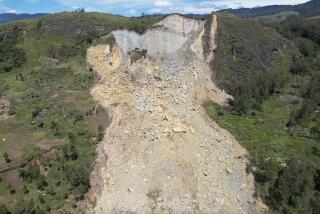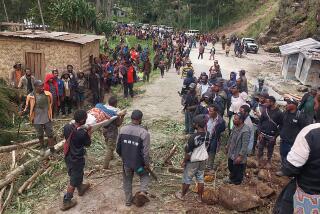Disease Threatens Survival of Remote, Stone Age Folk
- Share via
WASHINGTON — A nomadic Papua New Guinea people, known to the outside world only since 1982, may be on the brink of extinction, victims of diseases that are steadily reducing their numbers faster than they can be replenished.
The about 600 Stone Age people, called the Hagahai--the name means simply “people” in their language--have been hunting and foraging in a remote mountain area for thousands of years, their nomadic ways nearly unchanged.
But now, barring an unforeseen medical breakthrough, they are an endangered species, “definitely as important as sandhill cranes and snail darters,” says Carol L. Jenkins, a medical anthropologist who has been studying their life style since 1984. “There aren’t many people like these left.”
The Hagahai themselves know they’re in trouble. Aware that their numbers are dwindling, a delegation of five men sought help in 1983 from distant Baptist missionaries.
In April, 1984, an evangelist with medical training established a base among the Hagahai, who live in New Guinea’s western Schrader Range.
That July, a census patrol arrived in Hagahai territory for the first time. The patrol was accompanied by a team that included Philadelphia-born Jenkins, a research fellow at the Papua New Guinea Institute of Medical Research. Jenkins, whose work has been supported by the National Geographic Society, has since returned five times.
The Hagahai, she has learned, have been afflicted for a long time by endemic diseases such as malaria, elephantiasis, diphtheria, and hookworm.
Damaging epidemic diseases such as mumps, influenza, and hepatitis have been added to these chronic diseases in recent years by contact with outsiders and changes in settlement patterns.
Because of poor health, the Hagahai population is dying faster than it is being replaced. The estimated birthrate is 32 per 1,000 persons, contrasted with a death rate of 46 per 1,000, Jenkins says.
As many as 50% of the Hagahai die in their 30s, often from the breakdown of their immune systems, Jenkins says. By age 18, two-thirds of Hagahai youth have lost one or both parents. Most children never know their grandparents.
Hagahai women marry late, contributing further to the people’s decline. Infanticide is commonly practiced but little talked about, and Jenkins suspects that the killing of female babies skews the population toward more males.
To save the Hagahai, “We’re doing what we can with available medicine and vaccines,” Jenkins says. “We’ll make an attempt. But I don’t have a lot of hope.”
The best hope for the long-term survival of the Hagahai would be an anti-malaria vaccine that would not require them to change their ways, Jenkins says. But such a vaccine is yet to be developed.
Another way to prolong the Hagahai’s survival for perhaps another 50 or 60 years, Jenkins says, would be to transform them into farmers. “That changes their entire culture, and it cuts down their mobility and their autonomy,” she says. “And it has serious consequences. It would destroy the Hagahai as they are now.”
Her actual prognosis is gloomier still. She doesn’t see the Hagahai as farmers. “What’s more likely to happen, unless we have a lot of very positive input, is that they’ll die out within 20 years,” she says.
Jenkins first heard about he Hagahai in 1982 while she was working on a nutrition survey in the highlands. Her source was “a little old man who was sitting there in a bark-cloth G-string around the fire at night, telling me about these wild people.”
Patrol officers for that region confirmed that a census had never been conducted there, and planned one for 1983. But it was postponed for a year when word of the Hagahai was leaded to the press by an over-eager young patrol officer.
At first the Hagahai were mystified by the white American and confused about her sex, because she was fully clothed. Then her husband and son paid a visit, and through hand motions she explained their relationship to her.
“Then they understood,” she says. “And the women came up and felt my breasts. And when they felt my breasts--oh, eureka!--this look of recognition on their faces. She is female!”
Jenkins found herself among people who sleep on the ground, in caves or lean-tos; who hunt with crude bows and arrows; who have acquired a few steel axes and knives through trade, but generally rely on handmade tools.
They worship the spirits of their ancestors. Their dead are laid out on scaffolds. After the bodies become skeletons, a pig is slaughtered sacrificially and most of the bones are deposited in a tree or cave. A widow may keep her husband’s jawbone as a memento. “She often sleeps with it,” Jenkins says. “She says it’s her protection.”
On one helicopter reconnaissance trip in search of a Hagahai subgroup, Jenkins saw five or six men run into the woods surrounding an opening. “And one of them remained in the middle and began shooting arrows up at the helicopter to try to keep us away,” she said.
But the decision of the Hagahai to seek outside assistance four years ago was “an irrevocable move,” in Jenkins’ view. The missionaries’ presence “opens their minds in dozens of ways, which is unavoidable,” she said. “They are now going to be exposed to everything, little by little.”
The independent nation of Papua New Guinea occupies the eastern half of the South Pacific island of New Guinea, second-largest island on earth, which it shares with the Irian Jaya, a province of Indonesia.
Two New Guinea territories administered by Australia merged in 1949 and became independent in 1975. Although well embarked on democratic self-rule, Papua New Guinea still depends on Australia for much of its budget.
In contrast, Irian Jaya, part of the last shred of Dutch colonial rule in the East Indies, seethes with revolt by native separatists nearly a quarter century after a 1963 plebiscite linked it with Indonesia.
An unruly landscape in Papua New Guinea, with knife-like ridges, swampland and thick interior jungle, splinters more than 750 tribes of Melanesian stock, each with its own language and little sense of national identity. Tribal warfare has been a way of life for centuries.
Papua New Guinea also takes in a number of smaller islands, including Bougainville and the Bismarck Archipelago.
More to Read
Sign up for Essential California
The most important California stories and recommendations in your inbox every morning.
You may occasionally receive promotional content from the Los Angeles Times.













